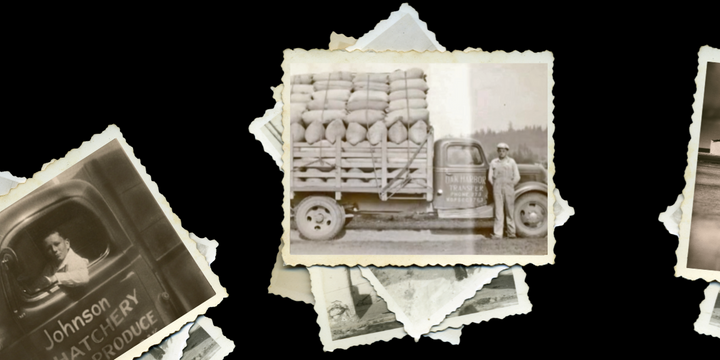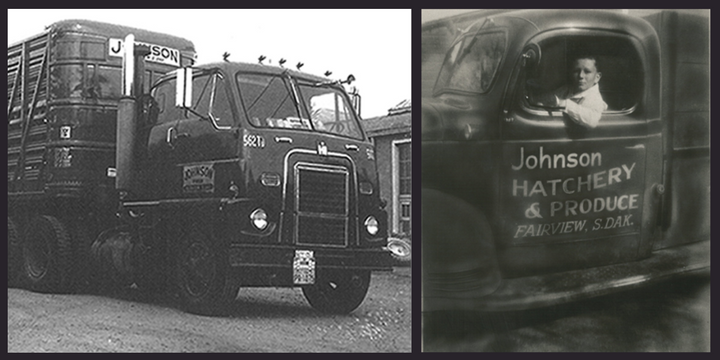Trucker Access › Forums › Diesel News › Two Trucking Fleets That Have Stood the Test of Time – Fleet Management
- This topic has 0 replies, 1 voice, and was last updated 11 months, 1 week ago by
 EazyRiDer66.
EazyRiDer66.
-
AuthorPosts
-
May 14, 2024 at 1:15 am #20387
 EazyRiDer66Keymaster
EazyRiDer66Keymaster

Two fleets that have stood the test of time have in common a multi-generational family story.
Graphic: HDT; Source: Johnson Feed, Oak Harbor
The 2022 year marked Heavy Duty Trucking’s 100th year of covering trucking. We’re highlighting a couple of motor carriers that have been around just as long, if not longer. While the two companies have very different operations, they have in common a multi-generational family story.
Johnson Feed Inc. — Canton, South Dakota
When Carl Johnson founded City Dray Line in 1920, the Prohibition era had just begun, Warren G. Harding was elected president, and car production was starting to ramp up to meet the demands of middle-class Americans. The trucking industry as we know it today was in its infancy.
In fact, when City Dray Line first opened for business, the company used a horse and wagon to deliver coal and other supplies to farmers near the small town of Fairview in Southeast South Dakota.
In the 1940s, Cliff Johnson, Carl’s son, started Johnson Feed, which was expanded to include local trucking. Cliff started with a single straight truck, and added two more, hauling grain, feed and livestock for local area farmers.

Johnson Feed Inc. grew from a horse-drawn wagon to the latest Kenworths through five generations of Johnsons.
Photos: Johnson Feed Inc.
In 1954, Darvin Johnson, Cliff’s son, returned home from the Navy to run the family business, adding semi-tractors to the fleet of straight trucks. Before long, there were five tractors running over-the-road. In 1983, Darv’s sons started joining him in business. In 1993, Johnson Feed moved into a warehouse, office, and shop in Canton, South Dakota.
“The late ‘80s is when we really started to grow the trucking side of our business and we’ve been growing at a 10-15% clip every year since,” said Todd Johnson, one of Carl Johnson’s great-grandchildren and one of the owners of the company, along with Mitch Johnson (another great-grandson) and three of Todd’s children.
Today, Johnson Feed operates 200 Kenworth T680s and has contracts with 120 owner-operators. It runs more than 1,000 reefer, dry van, and hopper-bottom trailers. And the “family” has grown to more than 375.
Oak Harbor Freight Lines — Auburn, Washington
Oak Harbor Transfer, the forerunner to Oak Harbor Freight Lines, was founded in 1916 by Ben Koetje of Oak Harbor, Washington, a town on Whidbey Island that had been incorporated just a year earlier.
Originally, Oak Harbor was a local cartage carrier servicing the island. In 1936, John and Gus Vander Pol purchased the small carrier for $600 cash, and younger brother Henry joined them in 1937. They expanded beyond the island into Washington State. In 1942, the brothers purchased another small carrier called Oak Harbor Freight Lines, merging the two but keeping the latter name.
The brothers over time developed the carrier into a small less-than-truckload operation serving a number of counties in Western Washington. In 1974, Henry purchased the company in full, and his sons, Edward and David, began working with their father.

Oak Harbor began as a local transfer company and over the decades grew into a large regional LTL.
Photos: Oak Harbor anniversary video
With deregulation in 1980, Oak Harbor began its expansion, which continues today.
Today, the LTL carrier is based in Auburn, Washington, employing 1,700 people — about five times the city of Oak Harbor’s first census-counted population — and running 800 tractors and 2,400 trailers across five western states with 38 terminals.
Formerly owned and operated by David and Ed Vander Pol, the next generation of Vander Pols have taken up the mantle to run the company, with Eric Vander Pol and Dan Vander Pol acting as co-presidents.
Some other trucking companies that have hit their centennial in recent years include C.R. England of Salt Lake City, Utah; and Hogan Transports of St. Louis, Missouri.
This article appeared in the November/December 2022 issue of Heavy Duty Trucking.
-
AuthorPosts
- You must be logged in to reply to this topic.